roof FIAT DOBLO COMBI 2016 2.G Owners Manual
[x] Cancel search | Manufacturer: FIAT, Model Year: 2016, Model line: DOBLO COMBI, Model: FIAT DOBLO COMBI 2016 2.GPages: 298, PDF Size: 25.92 MB
Page 14 of 298
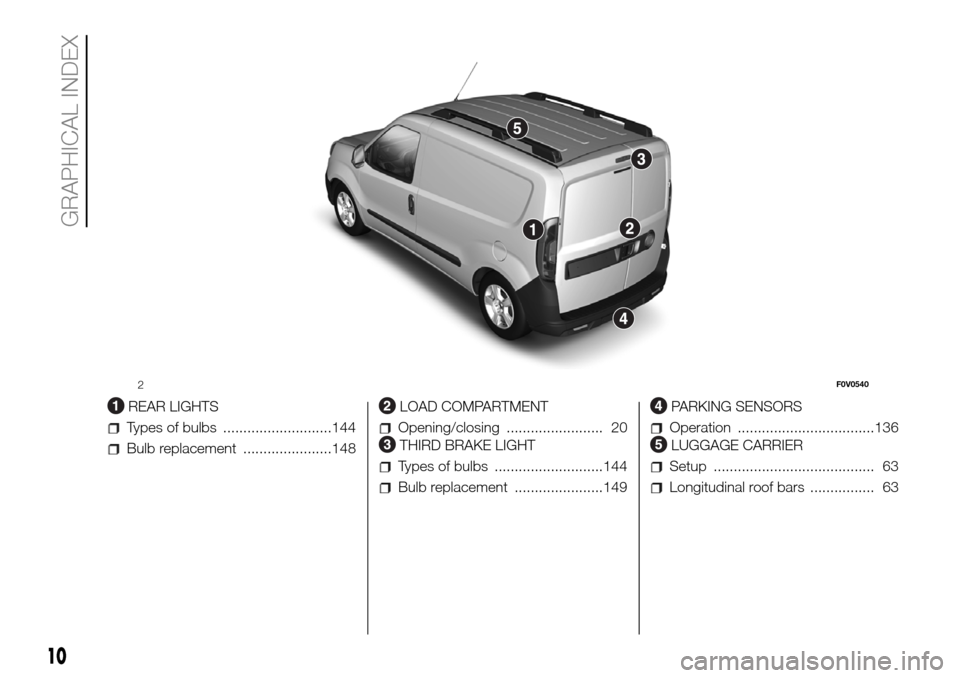
.
REAR LIGHTS
Types of bulbs ...........................144
Bulb replacement ......................148
LOAD COMPARTMENT
Opening/closing ........................ 20
THIRD BRAKE LIGHT
Types of bulbs ...........................144
Bulb replacement ......................149
PARKING SENSORS
Operation ..................................136
LUGGAGE CARRIER
Setup ........................................ 63
Longitudinal roof bars ................ 63
2F0V0540
10
GRAPHICAL INDEX
Page 17 of 298
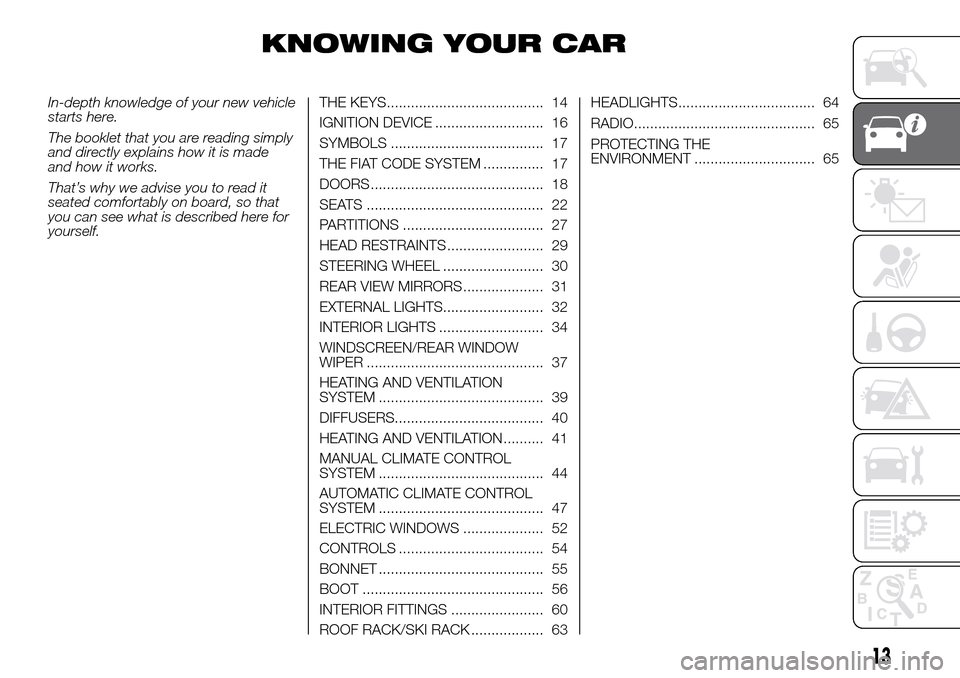
KNOWING YOUR CAR
In-depth knowledge of your new vehicle
starts here.
The booklet that you are reading simply
and directly explains how it is made
and how it works.
That’s why we advise you to read it
seated comfortably on board, so that
you can see what is described here for
yourself.THE KEYS....................................... 14
IGNITION DEVICE ........................... 16
SYMBOLS ...................................... 17
THE FIAT CODE SYSTEM ............... 17
DOORS ........................................... 18
SEATS ............................................ 22
PARTITIONS ................................... 27
HEAD RESTRAINTS ........................ 29
STEERING WHEEL ......................... 30
REAR VIEW MIRRORS .................... 31
EXTERNAL LIGHTS......................... 32
INTERIOR LIGHTS .......................... 34
WINDSCREEN/REAR WINDOW
WIPER ............................................ 37
HEATING AND VENTILATION
SYSTEM ......................................... 39
DIFFUSERS..................................... 40
HEATING AND VENTILATION.......... 41
MANUAL CLIMATE CONTROL
SYSTEM ......................................... 44
AUTOMATIC CLIMATE CONTROL
SYSTEM ......................................... 47
ELECTRIC WINDOWS .................... 52
CONTROLS .................................... 54
BONNET ......................................... 55
BOOT ............................................. 56
INTERIOR FITTINGS ....................... 60
ROOF RACK/SKI RACK .................. 63HEADLIGHTS.................................. 64
RADIO............................................. 65
PROTECTING THE
ENVIRONMENT .............................. 65
13
Page 23 of 298
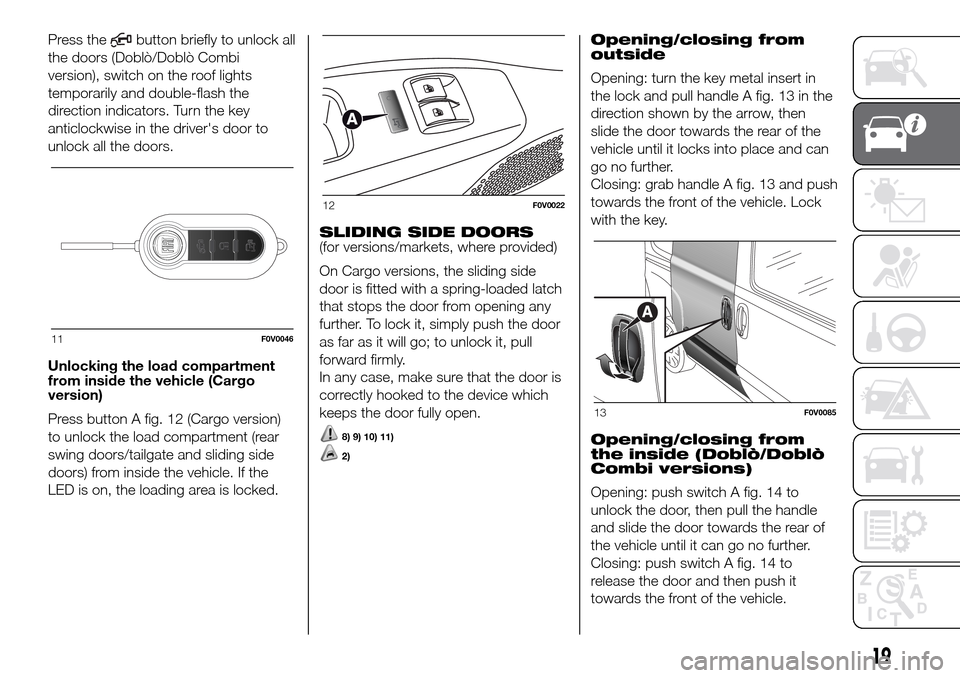
Press thebutton briefly to unlock all
the doors (Doblò/Doblò Combi
version), switch on the roof lights
temporarily and double-flash the
direction indicators. Turn the key
anticlockwise in the driver's door to
unlock all the doors.
Unlocking the load compartment
from inside the vehicle (Cargo
version)
Press button A fig. 12 (Cargo version)
to unlock the load compartment (rear
swing doors/tailgate and sliding side
doors) from inside the vehicle. If the
LED is on, the loading area is locked.SLIDING SIDE DOORS
(for versions/markets, where provided)
On Cargo versions, the sliding side
door is fitted with a spring-loaded latch
that stops the door from opening any
further. To lock it, simply push the door
as far as it will go; to unlock it, pull
forward firmly.
In any case, make sure that the door is
correctly hooked to the device which
keeps the door fully open.
8) 9) 10) 11)
2)
Opening/closing from
outside
Opening: turn the key metal insert in
the lock and pull handle A fig. 13 in the
direction shown by the arrow, then
slide the door towards the rear of the
vehicle until it locks into place and can
go no further.
Closing: grab handle A fig. 13 and push
towards the front of the vehicle. Lock
with the key.
Opening/closing from
the inside (Doblò/Doblò
Combi versions)
Opening: push switch A fig. 14 to
unlock the door, then pull the handle
and slide the door towards the rear of
the vehicle until it can go no further.
Closing: push switch A fig. 14 to
release the door and then push it
towards the front of the vehicle.
11F0V0046
12F0V0022
13F0V0085
19
Page 38 of 298

WARNING
27)The daytime running lights are an
alternative to the dipped beam headlights
for driving during the daytime in countries
where it is compulsory to have lights on
during the day, and they are also permitted
in those countries where this is not
obligatory. Daytime running lights cannot
replace dipped beam headlights when
driving at night or through tunnels. The use
of daytime running lights is governed by
the highway code of the country in which
you are driving. Comply with legal
requirements.
INTERIOR LIGHTS
FRONT ROOF LIGHT WITH
MOVABLE LENS
The light fades up or reaches full
brightness immediately if pushed at the
sides.
On the Doblò Cargo versions, it is only
connected to the front doors.
On the Doblò/Doblò Combi people
carrier versions, it is connected to the
front doors and the sliding side doors.FRONT ROOF LIGHT WITH
SPOT LIGHTS
(for versions/markets, where provided)
On the Doblò Cargo versions, it is
only connected to the front doors.
On the Doblò/Doblò Combi people
carrier versions, it is connected to the
front doors and the sliding side doors.
Switch A fig. 60 is used to switch on/off
roof lights.
With switch A in the middle position,
lights C and D go on/off when the
doors are opened/closed.
With switch A pressed to the left, the
lights C and D are always off.
With switch A pressed to the right, the
lights C and D are always on.
Lights switch on/off progressively.
Switch B controls the spot light
function; when the roof light is off, it
switches on individually:
- light C if pressed on the left side;
- light D if pressed on the right side.
IMPORTANT Before getting out of the
vehicle, make sure both switches are in
the middle position; when the doors
are closed, the lights switch off to
prevent the battery from being run
down. In any case, if the switch is left in
on position, the roof light switches off
automatically 15 minutes after the
engine switching off.
60F0V0055
34
KNOWING YOUR CAR
Page 39 of 298

REAR ROOF LIGHT WITH
MOVABLE LENS
(Doblò/Doblò Combi versions)
The light comes on automatically when
a front door or sliding side door is
opened and goes out when it is closed.
Press the left-hand side of the lens A
fig. 62, as shown in the diagram, to
switch the light on/off when the doors
are closed.REAR ROOF LIGHT WITH
MOVABLE LENS
(Cargo versions without fixed window)
This is located on the rear panel of
the load compartment. The light comes
on automatically when you open the
sliding side doors (for versions/markets
where provided) and the rear swing
doors/tailgate (for versions/markets
where provided), and goes out when
you close them. Press the left or right
side of the movable lens A, as shown in
fig. 63, to switch the light on/off when
the doors are closed.REAR ROOF LIGHT WITH
MOVABLE LENS
(additional for Cargo long wheelbase
versions)
This is located on the right side of the
load compartment. The light comes on
automatically when you open the sliding
side doors and the rear wing
doors/tailgate and goes out when you
close them.
Press the left-hand side of the lens A
fig. 63, as shown in the diagram, to
switch the light on/off when the doors
are closed.
LUGGAGE
COMPARTMENT LIGHT
(Doblò/Doblò Combi version)
The light fig. 64 comes on automatically
when the swing doors or tailgate (for
versions/markets where provided)
are opened and goes out when they
are closed.
61F0V0056
62F0V0057
63F0V0171
64F0V0172
35
Page 40 of 298
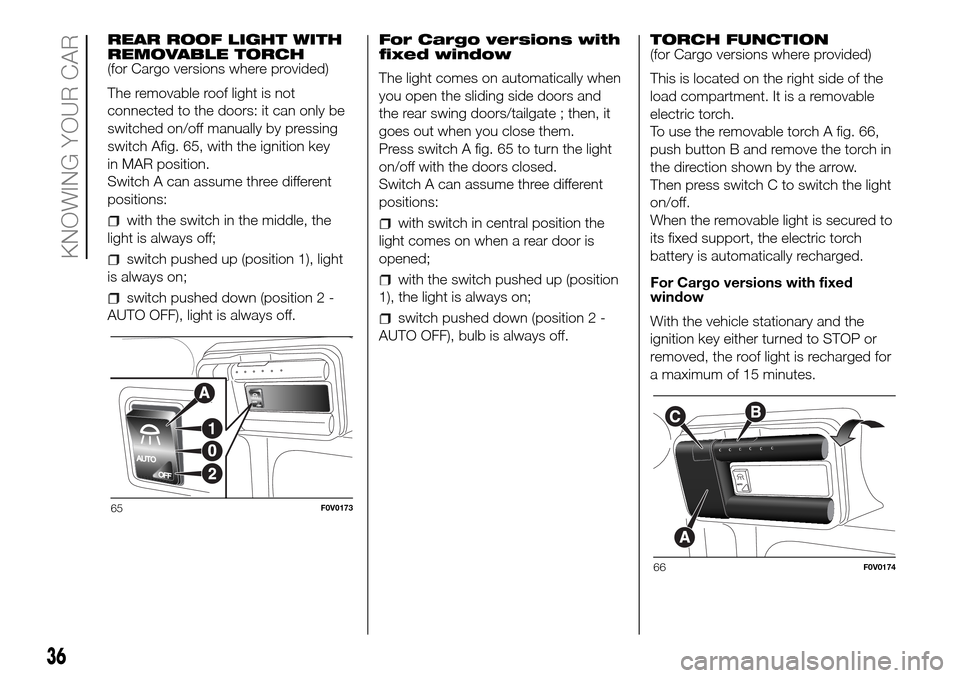
REAR ROOF LIGHT WITH
REMOVABLE TORCH
(for Cargo versions where provided)
The removable roof light is not
connected to the doors: it can only be
switched on/off manually by pressing
switch Afig. 65, with the ignition key
in MAR position.
Switch A can assume three different
positions:
with the switch in the middle, the
light is always off;
switch pushed up (position 1), light
is always on;
switch pushed down (position 2 -
AUTO OFF), light is always off.For Cargo versions with
fixed window
The light comes on automatically when
you open the sliding side doors and
the rear swing doors/tailgate ; then, it
goes out when you close them.
Press switch A fig. 65 to turn the light
on/off with the doors closed.
Switch A can assume three different
positions:
with switch in central position the
light comes on when a rear door is
opened;
with the switch pushed up (position
1), the light is always on;
switch pushed down (position 2 -
AUTO OFF), bulb is always off.TORCH FUNCTION
(for Cargo versions where provided)
This is located on the right side of the
load compartment. It is a removable
electric torch.
To use the removable torch A fig. 66,
push button B and remove the torch in
the direction shown by the arrow.
Then press switch C to switch the light
on/off.
When the removable light is secured to
its fixed support, the electric torch
battery is automatically recharged.
For Cargo versions with fixed
window
With the vehicle stationary and the
ignition key either turned to STOP or
removed, the roof light is recharged for
a maximum of 15 minutes.
65F0V0173
66F0V0174
36
KNOWING YOUR CAR
Page 41 of 298
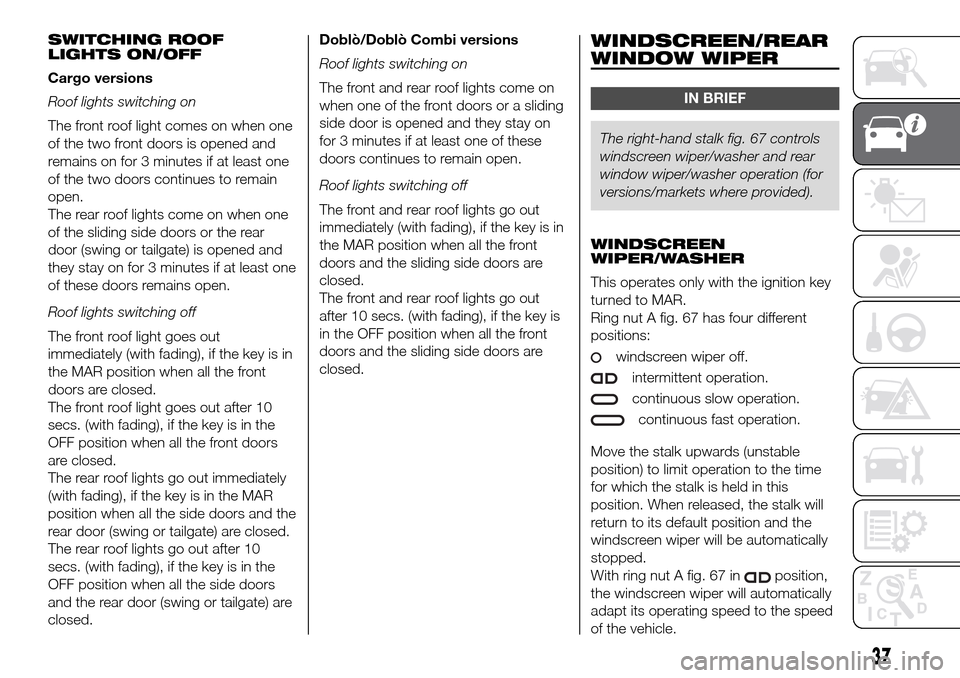
SWITCHING ROOF
LIGHTS ON/OFF
Cargo versions
Roof lights switching on
The front roof light comes on when one
of the two front doors is opened and
remains on for 3 minutes if at least one
of the two doors continues to remain
open.
The rear roof lights come on when one
of the sliding side doors or the rear
door (swing or tailgate) is opened and
they stay on for 3 minutes if at least one
of these doors remains open.
Roof lights switching off
The front roof light goes out
immediately (with fading), if the key is in
the MAR position when all the front
doors are closed.
The front roof light goes out after 10
secs. (with fading), if the key is in the
OFF position when all the front doors
are closed.
The rear roof lights go out immediately
(with fading), if the key is in the MAR
position when all the side doors and the
rear door (swing or tailgate) are closed.
The rear roof lights go out after 10
secs. (with fading), if the key is in the
OFF position when all the side doors
and the rear door (swing or tailgate) are
closed.Doblò/Doblò Combi versions
Roof lights switching on
The front and rear roof lights come on
when one of the front doors or a sliding
side door is opened and they stay on
for 3 minutes if at least one of these
doors continues to remain open.
Roof lights switching off
The front and rear roof lights go out
immediately (with fading), if the key is in
the MAR position when all the front
doors and the sliding side doors are
closed.
The front and rear roof lights go out
after 10 secs. (with fading), if the key is
in the OFF position when all the front
doors and the sliding side doors are
closed.WINDSCREEN/REAR
WINDOW WIPER
IN BRIEF
The right-hand stalk fig. 67 controls
windscreen wiper/washer and rear
window wiper/washer operation (for
versions/markets where provided).
WINDSCREEN
WIPER/WASHER
This operates only with the ignition key
turned to MAR.
Ring nut A fig. 67 has four different
positions:
windscreen wiper off.
intermittent operation.
continuous slow operation.
continuous fast operation.
Move the stalk upwards (unstable
position) to limit operation to the time
for which the stalk is held in this
position. When released, the stalk will
return to its default position and the
windscreen wiper will be automatically
stopped.
With ring nut A fig. 67 in
position,
the windscreen wiper will automatically
adapt its operating speed to the speed
of the vehicle.
37
Page 67 of 298

WARNING
41)Never travel with the glove
compartment open: it could injure the
passenger in the event of a crash.
42)The cigar lighter becomes very hot.
Handle it carefully and make sure that
children don't touch it: risk of fire and/or
burning.
43)Do not use the ashtray as a waste
paper basket: it may catch fire in contact
with cigarette stubs.
ROOF RACK/SKI
RACK
44) 45)
8) 9)
FASTENERS
The fasteners are located at points A, B
and C fig. 109.ROOF RAILS
(for versions/markets, where provided)
On some versions, the vehicle has
two longitudinal bars which, with the
addition of special accessories, can be
used to carry various objects (e.g.
skis, surfboards, etc.).
WARNING
44)Strictly adhere to the laws in force
concerning maximum clearance.
45)Check that the attachment fixing
screws are tight after a few kilometres.
WARNING
8)Evenly distribute the load and take into
account, when driving, the increased
responsiveness of the vehicle to side wind.
9)Never exceed the maximum permitted
loads (see chapter “Technical
specifications”).109F0V0123
63
Page 125 of 298

SIDE BAGS
(for versions/markets, where provided)
On some versions, the vehicle may
be fitted with driver and passenger front
side airbags for head and torso
protection.
Side bags protect occupants from
side-on crashes of medium/high
severity by placing the bag between the
occupant and the internal parts of the
side structure of the vehicle.
Non-activation of side bags in other
types of collisions (front collisions, rear
shunts, roll-overs, etc.) is not a system
malfunction.
An electronic control unit causes the
bags to inflate in the event of a side-on
collision. The bags inflate
instantaneously, placing themselves
between the occupant's body and the
structures which could cause injury.
They deflate immediately afterwards.
Side bags are not a replacement of, but
rather a complement to, seat belts,
which you are recommended to wear at
all times, as specified by law in Europe
and most non-European countries.For this reason, the seat belt must be
worn at all times. In the case of side-on
collisions, the seat belts hold occupants
in the correct position in relation to the
airbag and prevent them from being
thrown out of the vehicle by a very
violent collision.
SIDE BAGS
(for versions/markets, where provided)
It consists of an instantly inflating bag
housed in the front seat backrest . It
protects the passengers’ head, chest
and shoulder areas in the event of side
crashes of medium-high severity fig.
139.
IMPORTANT In the event of side
impact, you can obtain the best
protection from the system by
maintaining a correct position on the
seat, thereby allowing the side bag
to deploy correctly.
IMPORTANT Do not wash the seats
with water or pressurised steam (by
hand or at automatic seat washing
stations).
WINDOW BAG
(for versions/markets, where provided)
These consist of two “drop-down”
cushions, housed behind the side trim
of the roof and covered with finishing
elements .They are designed to protect the head
of front and rear occupants in the event
of a side collision, thanks to the wide
cushion inflation surface.
The deployment of side bags in the
event of side impacts of low severity is
not required.
139F0V0026
121
Page 143 of 298

SAVING FUEL
Some useful tips are given below for
fuel saving and reducing harmful
emissions of CO2 and other pollutants
(nitrogen oxides, unburnt
hydrocarbons, Particulate Matter (PM),
etc.).
PRACTICAL ADVICE FOR
REDUCING FUEL
CONSUMPTION AND
HARMFUL EMISSIONS
Vehicle conditions
Have checks and adjustments for
vehicle maintenancecarried out
in accordance with the “Scheduled
servicing plan”.
Checktyrepressure regularly, at
least once every four weeks.
Excessively low pressures will increase
consumption because rolling resistance
will be higher. In addition, this wears
the tyre more quickly and impairs
performance.
Only usesnow tyreswhen the
weather conditions make them
absolutely necessary. They increase
consumption and noise.
Do not travel witha heavy load: the
weight of the vehicle (especially when
driving in town) and its geometry greatly
affect fuel consumption and stability.
Removeroof racks or ski racks
after use. These accessories reduce the
vehicle's aerodynamic penetration and
have a negative effect on fuel
consumption.
When transporting particularly large
objects, use atrailerif possible.
Use the vehicle's air vents if
possible: travelling with the windows
open impairs aerodynamics.
Use electrical devices only for the
amount of time needed. The vehicle’s
heated rear window, additional
headlights, screen wipers and heater
fan require a considerable amount
of energy; this increases fuel
consumption (by up to +25% in an
urban cycle).
Air conditioning leads to higher fuel
consumption (on average up to +30%).
If the temperature outside is not too
extreme, try and use the air vents.
Driving style
Afterstarting the engineyou
should drive away immediately and
slowly, avoiding high revs. Do not warm
up the engine at low or high revs when
the vehicle is stationary; this causes
the engine to warm up more slowly,
thereby increasing fuel consumption,
emissions and mechanical component
wear.
Avoidpointless actionssuch as
revving up when at traffic lights or
before stopping the engine. The latter
action, like double-declutching, is
unnecessary and causes increased fuel
consumption and pollution.
Gear selection:select a high gear
as soon as possible (taking into
account normal engine operation and
traffic conditions) without pushing
the engine to high revs during
the intermediate gears. Using low gears
at high revs to get lively acceleration
increases fuel consumption, harmful
emissions and engine wear.
Vehicle speed:fuel consumption
increases exponentially as the speed of
the vehicle increases. Keep your speed
moderate and as even as possible,
avoiding unnecessary braking and
acceleration, which cause excessive
fuel consumption and increased
emissions. Keeping a safe distance
from the vehicle in front helps to
maintain a steady speed.
Acceleration:accelerating violently
severely affects consumption and
emissions. Acceleration should be
gradual and should not exceed the
maximum engine torque rate.
139